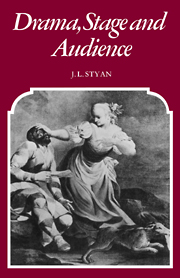6 - Non-illusory theatre
Published online by Cambridge University Press: 02 December 2009
Summary
It came as a delight and a surprise when the Royal Shakespeare Company's players introduced themselves without ado at rise of curtain in the formalistic openings of Clifford Williams's Comedy of Errors (1962) and Peter Brook's Dream (1970). Role-playing in its own time, however, was symptomatic of a kind of theatre so familiar to its audiences that its frank unreality was unremarkable. When Edgar in King Lear announced flatly to his audience, ‘Edgar I nothing am’, doubtless the Elizabethans heard this with less confusion than we do today. For us it means that Edgar chooses to suppress his identity; for them, it meant that the young male lead would assume another persona – a public and objective rather than a private and subjective function. One thing is clear: his image as the wronged son of the Duke of Gloucester was secondary to the work he next performed as ironic chorus to mad Lear and blind Gloucester. And this role-playing was only to subserve the whole illogical mode of theatre which swept its audience on to the heath and into the phantasmagoria of Lear's massive tragedy.
Illusion is the province of all theatre: a spectator goes to the playhouse in the expectation that he will be free to indulge it. In an introduction to Pirandello's Six Characters in Search of an Author, Lionel Trilling wrote, ‘The word illusion comes from the Latin word meaning “to mock” (illudere), which in turn comes from the word meaning “to play” (ludere), and a favourite activity of the theatre is to play with the idea of illusion itself, to mock the very thing it most tries to create – and the audience that accepts it.’
- Type
- Chapter
- Information
- Drama Stage and Audience , pp. 180 - 223Publisher: Cambridge University PressPrint publication year: 1975



